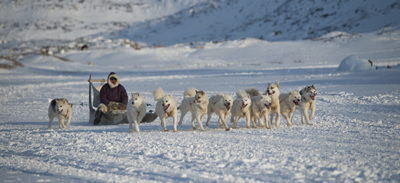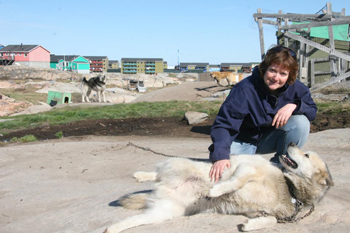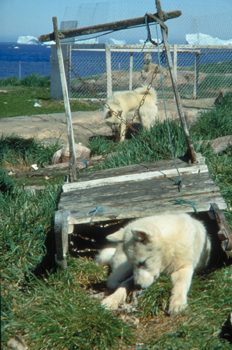From the Editor: A Kaleidoscope of Activity
Is there a vet in the house?
The Sledge Patrol update
In Search of John Flick
My Life with Dogs
Canadian Inuit Dogs I have owned, raised and trained:
a photo essay; Part 2
Inuk VOD Release
From the NFB Archives: How to Build an Igloo
Film Review: People of a Feather
IMHO: What Do You See?
Navigating This Site
Index of articles by subject
Index of back issues by volume number
Search The Fan Hitch
Articles to download and print
Ordering Ken MacRury's Thesis
Our comprehensive list of resources
Defining the Inuit Dog
Talk to The Fan Hitch
The Fan Hitch home page
Editor: Sue Hamilton
Webmaster: Mark Hamilton
The Fan Hitch, Journal
of the Inuit Sled Dog, is published four
times a year. It is available at no cost
online at: https://thefanhitch.org.
The Fan Hitch welcomes your letters, stories, comments and suggestions. The editorial staff reserves the right to edit submissions used for publication.
Contents of The Fan Hitch are protected by international copyright laws. No photo, drawing or text may be reproduced in any form without written consent. Webmasters please note: written consent is necessary before linking this site to yours! Please forward requests to Sue Hamilton, 55 Town Line Rd., Harwinton, Connecticut 06791, USA or mail@thefanhitch.org.
This site is dedicated to the Inuit Dog as well as related Inuit culture and traditions. It is also home to The Fan Hitch, Journal of the Inuit Sled Dog.
The Fan Hitch welcomes your letters, stories, comments and suggestions. The editorial staff reserves the right to edit submissions used for publication.
Contents of The Fan Hitch are protected by international copyright laws. No photo, drawing or text may be reproduced in any form without written consent. Webmasters please note: written consent is necessary before linking this site to yours! Please forward requests to Sue Hamilton, 55 Town Line Rd., Harwinton, Connecticut 06791, USA or mail@thefanhitch.org.
This site is dedicated to the Inuit Dog as well as related Inuit culture and traditions. It is also home to The Fan Hitch, Journal of the Inuit Sled Dog.

Greenland
Is there a vet in the house?
Now that an outbreak of a deadly dog virus in northern Greenland appears to have been halted, officials are asking how they can prevent it from happening again

Greenland dog sledge Photo: Leiff Josefsen
February 3, 2016 - 7:13am - by The Arctic Journal
After the deaths of as many as 70 dogs in northern Greenland, authorities say they are now on their way getting an outbreak of distemper under control.
A total of 400 dogs in the settlements of Qeqertaq and Saqqaq were vaccinated this weekend, about a week after the first reports of the deaths emerged.
The first indication of a distemper outbreak in the area came to light on January 26, when 20 dogs in Qeqertaq, primarily young dogs from two packs, and another five in the nearby settlement of Saqqaq, were said to have died suddenly.
Veterinarians said the conditions of the deaths in Qeqertaq appeared to indicate the presence of distemper, a highly contagious canine virus. Once contracted the virus is incurable, and by Saturday the number of dogs reported to have died from the illness or put down after becoming infected had risen to 70. More deaths are likely, officials say.
Vaccinations are free and obligatory, however the reported lack of a veterinarian to administer vaccine in the area had meant that many have have gone unprotected.
Outbreaks of distemper occur on an occasional basis in Greenland with varying degrees of seriousness. An outbreak in 1987-88 near Qaanaaq, for example, killed about 300 dogs and caused widespread economic hardships for many living in the area.
Part of the responsibility for preventing new outbreaks lies with dog owners, say officials. In connection with this weekend's vaccinations, they were reminded of the need to give dogs booster shots and to keep packs of dogs confined and separated. Should a dog become ill, it should be isolated and, in the event it dies of its illness, its remains must be incinerated.
However, the outbreak also has lawmakers in the region and elsewhere looking at whether they can provide dog owners with the help they need to make sure their dogs get vaccinated. Previously, two veterinarians were employed by the national government to vaccinate the estimated 12,000 sledge dogs in northern Greenland.
Spending cuts led to one of the positions being cut and the remaining veterinarian had reportedly been on sick leave, resulting in a one-year gap in vaccinations.
Making matters more complicated, the vaccines were stored in the home of the veterinarian, who was reportedly abroad at the time the outbreak began and was unable to be contacted for permission to enter into her home.
Because the veterinarian was also registered as the dispenser of the medicine, it was considered her personal property, and that, local officials said, meant they could not break into the home and take it. It was a series of events, Ole Dorph, the head of the Qaasuitsup local council, admitted to KNR, a broadcaster, that they were unprepared for.
“This was complicated situation. It’s not easy to get your hands on a veterinarian when you need one.”
That difficulty has resulted in is this being winter of their distemper.
This article and its accompanying photograph have been reprinted with the kind permission of The Arctic Journal. Ed.
* * *
The Fan Hitch is delighted to offer the following response to its inquiry and to The Arctic Journal story, “Is there a vet in the house?”
Dear Dr. Wennerberg,
My name is Sue Hamilton. I am the owner, publisher and editor of The Fan Hitch, Website and Journal of the Inuit Sled Dog. Recently I read a disturbing article in the February 3 issue of The Arctic Journal, "Greenland: Is there a vet in the house?". The Arctic Journal has granted me permission to reproduce that article in the March issue of The Fan Hitch, a quarterly on-line only publication.
For twenty-five years, my husband and I took all our vacations in the arctic, mostly Canada but in 1997 we enjoyed a visit to Ilulissat and some days out on the ice by dog teams. We also got to meet the veterinarian on duty there and later we were in communication with the veterinarian who followed him into the same position. It was our understanding that veterinary service to Greenland communities beyond Ilulissat (except for the Sirius Patrol Dogs of East Greenland) was provided by skilled lay persons who were in communication with the Ilulissat veterinarian regarding overall canine community health issues, from routine vaccinations, castrations and spays, to trauma treatment to team owner educational efforts.
I am wondering if you could confirm (or deny) this model as I understood it. Can you describe the current plan to bring veterinary services to Greenland's dog team owners? I am eager to present in The Fan Hitch how veterinary and related care in general is delivered or at least offered to Greenland Dog owners. And in the case of the February 3rd article in The Arctic Journal, what is being done to have vaccines more accessible. Or is vaccination an "issue" coming from team owners side of this equation?
Sadly, Greenland has been sorely underrepresented in The Fan Hitch during its 17+ year existence and this might be a good place to start changing that.
Thank you for your time. I look forward to hearing from you.
Sue Hamilton

File photo of the official veterinarian in Ilulissat , Sanne Eline Wennerberg
Photo: Niels Ole Qvist; courtesy of S. Wennerberg
Dear Sue,
You wrote: "It was our understanding that veterinary service to Greenland communities beyond Ilulissat (except for the Sirius Patrol Dogs of East Greenland) was provided by skilled lay persons who were in communication with the Ilulissat veterinarian regarding overall canine community health issues, from routine vaccinations, castrations and spays, to trauma treatment to team owner educational efforts…".
Sadly this is not the way it works, or has ever worked. I am employed by the Government of Greenland. A part of my job description is to give service to the sled dog owners. But as you know Greenland is not an easy or cheap country to travel in, so there are limitations to my travelling. Most support and consultancies are given by phone or information campaigns. I am working closely with the municipalities. They have "dog vaccinators" which are trained to vaccinate against rabies and they normally keep an eye on the dogs’ well being also. The dog owners can buy antibiotics, deworming and contraception medicines directly through me. Also, the municipalities get this from me to sell to the dog owners. When I have the possibility to travel, I always meet with the "dog vaccinator" to train and advise him. I also work closely with the police and especially with their dog patrols because of their understanding of dogs.
So this is how it works, and there is only me here in Ilulissat. I am one of 3½ veterinarians working for the government. One is placed in the south working primarily with the farmers. 1½ are located in Nuuk, Greenland’s capital (the ½ person works part time at the clinic in Nuuk).
I would like to make some clarifications on The Arctic Journal story.
"Vaccinations are free and obligatory, however the reported lack of a veterinarian to administer vaccine in the area had meant that many have gone unprotected."
The vaccine against rabies is free and obligatory. The vaccine against distemper virus and parvovirus is a voluntary vaccine that the dog owners can buy. For many, many years we have tried to make the dog owners understand the necessity of vaccinating the bitch and the puppies against these diseases. Only a few do it. I do not know why. Most sled dog owners have had dogs their whole lives, those skills taught to them by their fathers or grandfathers. These are working dogs with a working relationship to their owners.
Outbreaks of distemper are not a new thing in Greenland and the knowledge of how and why to prevent it is out there. Another problem is the way some owners choose to have their dogs, allowing puppies to run free until the age of six months. Often those dog owners cannot call the dogs in so there are quite some loose dogs running around too.... that causes a great problem concerning containing diseases.
"Making matters more complicated, the vaccines were stored in the home of the veterinarian, who was reportedly abroad at the time the outbreak began and was unable to be contacted for permission to enter into her home."
The vaccines are stored at the office, not my home. And it would have been possible to get a key. But the main problem here was that everybody thought the vaccine was a cure. And everybody was in a kind of panic state. So of course my colleagues did not want to hand out the key to anybody who did not know what they were doing! In this situation the main thing was to make sure that the villages were properly advised on how to handle the situation, and they got that information.
The whole situation has been very sad and complicated. Having more veterinarians is not necessarily the answer. The distemper/parvo vaccine is available. The dog owners can buy these and carry out the vaccinations themselves. I am aware that this system is far from good enough mainly because of the lack of registration and documentation of which dogs have been vaccinated. This is why we will try to make it obligatory so these vaccinations can be carried out by the "dog vaccinator" and we can set up a system to register distemper/parvo vaccinations like we do for rabies. The Veterinary Authority is at the moment, elaborating the possibility to enforce an obligatory vaccination program against distemper/parvo by law. However, such enforcement will need collaboration and goodwill from all involved – dog owners, municipalities, politicians etc.

Puppies and dog sled in Ilulissat, Greenland
Courtesy Greenland Tourism
Addressing the roaming dog problem, a real challenge to controlling diseases, is also very important. Educating those owners who don’t yet appreciate the benefits of keeping puppies from roaming in addition to encouraging them to vaccinate against distemper and parvovirus will help.
I do appreciate that people from outside Greenland care and look into the challenges we face here concerning the well being of the Greenlandic Sled Dog. But I do hope that questions will be put forward before jumping to conclusions. So please, any questions concerning Greenlandic Sled Dogs can be sent to: uumasut@nanoq.gl.
Best regards,
Sanne Eline Wennerberg, DVM
Senior Veterinary Officer
Veterinary & Food Authority of Greenland